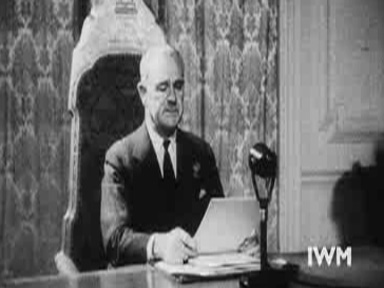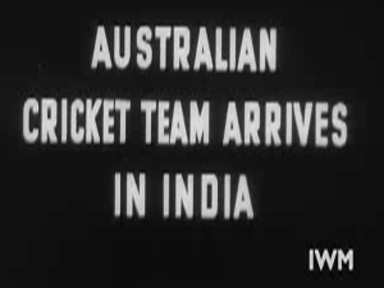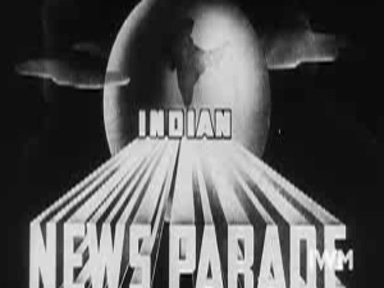I. VICEROY VISITS EASTERN FRONT - Pictures of His Excellency The viceroy, Lord Linlithgow's flying visit to the ...
Indian News Parade

Between 15 September 1943 and 26 April 1946 the Government of India produced 126 issues of its weekly newsreel, Indian News Parade. With 89 copies released each week in five languages (43 in Hindustani, 26 in English, 9 in Tamil, 7 in Bengali, and 4 in Telegu), Indian News Parade played in most of the estimated 1,400 cinemas in British India, was widely exhibited around the country by 75 35mm mobile cinema vans and was also re-edited on 16mm for exhibition, through the Village Publicity Scheme, in rural communities (L/I/I/692). Its close ties with the British government made it the subject of criticism from both the nationalist Indian press and much of the cinema-going public. Yet for historians today these films provide a valuable record of the last years of British rule in India, highlighting in particular the government’s use of film as a didactic tool during the war and the government’s shifting responses to India’s impending independence.
In September 1942, Sir Edward Villiers of the Films Division of the Ministry of Information confirmed the establishment of a fortnightly Indian-produced newsreel. Villiers stated that Indian Movietone News would contain ‘approximately 50% civil material, 25% military material and 25% British and other material. The reason for this allocation’, he wrote, ‘is that Indians, with the exception of the Europeanised ones are so uninterested with anything other than Indian shots that it has been found almost impossible to get them to look at the ordinary newsreel’ (INF 1/569). Prior to this, the government had been entirely reliant on foreign newsreels, most notably British Movietone News, British Paramount News (both under the direct control of US companies) and Gaumont British News, all of which catered predominantly for the urban English language cinemas (which numbered fewer than 200). Although an arrangement was reached in 1940 for British Movietone News to dub their newsreels in four local languages, the Indian government continued to complain that these imported newsreels did not show enough Indian troop activity, and that they were invariably out of date by the time they reached Indian screens (Sargent, 1999, 32). The speedy arrival of the American newsreel, United News, in 1942, which was soon produced in a vernacular version for Indian cinemas, further highlighted these failings. The Indian government manoeuvred the withdrawal of United News from Indian cinemas, amidst concern that its representation of the war effort promoted American involvement and was unsympathetic to British imperialism (Woods, 2000, 100). This intervention, and the concurrent establishment of Indian Movietone News was prompted by British fears regarding America’s influence in, and relationship to, India. However, it also highlighted the government’s increasing recognition of film as a means of mass communication and the acknowledged need to tailor this propaganda specifically to an Indian audience.
While the government subsidised Indian Movietone News, correspondence emphasised that it would exercise ‘no direct control over the newsreel’ and that Mr C.B. Newbery, the Managing Director of Twentieth Century Fox India, would be completely responsible for its production and distribution. These early newsreels sought to promote all aspects of the Indian war effort although, in the absence of official war film from the massively under-staffed Indian Army Public Relations Unit, items were often rather tenuously linked to the war (see entry for Indian Movietone News 19). On first viewing an issue in London, members of the Ministry of Information deemed it ‘very disappointing’, while Film India also criticised its failure to address the country’s social problems (Indian Movietone News 9; INF 1/569; Film India, February 1943, 19).
India’s increasingly prominent role within the war effort, coupled with the continued rise of Indian nationalism (evident in the ‘Quit India’ movement of 1942) forced the government of India into a ‘more and more interventionist role in relation to the cinema trade’ (Woods, 2000, 100). On 15 May 1943, the government issued a directive under Rule 44-A of the Defence of India Act, which made it mandatory for each cinema in British India to exhibit at each performance a minimum of 2,000 feet of film approved by the government (see Indian News Parade 39). The Journal of the Film Industry suggested that ‘the notification of compulsion seems to be an admission by Government that the more interesting class of the public found the films [Indian Movietone News] uninteresting’, and complained that ‘25 minutes foisted on in India is positively unjust to exhibitors and unfair to the public who will not fail to devise their own ways to save themselves from the indigestion’ (The Journal of the Film Industry, June 1943, 11, 12). Exhibitors, unhappy at having to show the films, were even more distressed at having to pay a rental for them. Such a practice, they argued, ‘smacked more of totalitarianism than democracy’ (Garga, 2007, 102).
To fulfil the requirements of this new directive, Sir Sultan Ahmed, the Government of India Member for Publicity and Information, announced on 8 August 1943 that the government would assume full control of the production and distribution of the newsreel, and that this would now be renamed Indian News Parade. ‘This will serve no direct propaganda bias, but it will serve as a continual encouragement to our people by reflecting the war effort which appears in their daily lives’, he stated, adding that ‘it will encourage among us an international interest in international affairs and among foreigners a more direct knowledge of India and how it lives’ (Sargent, 1999, 29). The first issue of the weekly Indian News Parade was released as the new directive came into operation on 15 September 1943, with William J. Moylan, an Irishman working in India since 1927, serving as Director of Production.
Historical accounts of Indian News Parade have emphasised that the newsreel focussed predominantly on war propaganda and ‘kept clear of political comment and controversy’ (Garga, 2007, 103). Certainly, the newsreel is often notable for what it doesn’t show, or put another way, these films are frequently about what they are not about (see for example INP 56, the strikes in INP 139, the crash in INP 91). The Bengal famine is an excellent example of this, with its initial avoidance profoundly political. The newsreel’s carefully staged account of the famine presents the British and Indians working together to combat this ‘natural’ disaster and prioritises the humanitarian efforts of the British (see INP 55, 62, 84). In later issues, as Indian independence becomes imminent, the newsreel highlights the role of the Commonwealth in responding to the food ‘shortage’ (INP 160). Sanjoy Bhattacharya suggested that local publicity officials often ‘felt uncomfortable’ about the mass screenings of these episodes within the areas most effected by the shortages, as the films, with their jocular and jingoistic commentary, presented a triumphant account of British aid that was so removed from the experiences of millions of Indians (Bhattacharya, 2001, 95).
Aside from the Bengal famine, the newsreel showed other major events and incidents in Indian history, including the release of Gandhi from Aga Palace (INP 62), an item that the home department strongly objected to. The newsreels provide coverage of all of India’s religious communities (INP 71) and, increasingly, its political parties (the footage of Congress in INP 135). They frequently use sporting events to represent imperial or religious camaraderie (INP 91, 39, 139) and promote often changing international relations, for example with China (INP 39, 55). The items within the earlier issues of Indian News Paradeare largely united by their support of the war effort. They depict the work and, in particular, the welfare of Indian troops overseas (for example INP 62, 67), and show Indian troops receiving training (INP 74), as well as gaining recognition, usually within official formal ceremonies (INP 56). The newsreels advocate imperial cooperation and a colonial hierarchy in showing West African troops in Burma (for example INP 67, 70, 88, and 139), show Indian civilians supporting the war effort (INP 91) and also illustrate, as Jude Cowan demonstrated, the active role of (predominantly European) women within the war effort (INP 71, 84, 136).
A number of issues also begin to consider the plans for post-war India (INP 70, 71, 88), while later issues more explicitly address impending political changes, highlighting the ongoing, and rapidly changing, proposals for the transfer of power. The newsreel offers extensive coverage of the ‘Wavell Plan’ (INP 120), the British Parliamentary Delegation’s Tour of India (INP 155) and the Cabinet Mission (INP 160, 163). While the newsreels retain an emphasis on the British attempts to achieve a resolution, Indian political figures become increasingly prominent within them, from the footage of Congress (INP 135), to the coverage of Nehru (INP 160) and finally the Muslim League Legislators’ Convention (INP 163).
In promoting Indian News Parade in 1944, the Information Films of India annual stated that ‘the arrival of the newsreel in India has coincided with one of the most critical junctures in her long and glorious history, and its ever-increasing popularity with millions of cinema-goers is ample testimony of the nation’s appreciation of news in its most vivid form – on Silver Screen’. While the annual’s claims for the newsreel’s historical significance (‘the first weekly newsreel to be produced in India’, ‘the first successful attempt to bring news of India and Indian interest to the public through the medium of cinema’) may be valid, those claims of the newsreel’s ‘ever-increasing popularity’ were certainly not (‘Information Films of India Annual 1944’, 84). From the outset, the Indian film press strongly criticised the newsreel, for its editorial policies, its content and its lack of action footage (INP 56, Indian Movietone News 9). Viewers also resented its constant presence on cinema screens, which ensured that those regularly attending the cinema would often endure repeated viewings of each issue. ‘Now after nearly six months working’, a European resident wrote to the MOI, ‘the scheme is getting on the cinema-going public’s nerves and a considerable amount of harsh talk is ensuing, which to my mind, completely eliminates all the original propaganda value’. These views, he explained, were based on ‘listening to many of my friends both Indians, Europeans and Americans alike who are at a loss to know what it is all about and complain bitterly’ (‘Leach to Joyce’, L/I/I/686). The most fervent opposition responded, however, to the newsreel’s political affiliations. Attacked on patriotic, nationalist grounds, as a tool for the ‘alien government’ (particularly on account of its strong support for the war), Indian News Parade was deemed increasingly out of touch with its domestic audience.
The pressures on Indian News Parade, as a government-sponsored newsreel, intensified after the War and in later issues the newsreel sought to justify its continued existence by frequently promoting its potential role as a modern news service within post-war India (INP 136, 139, 155). It wasn’t to work. On 12 March 1946, a meeting of the Congress-dominated Central Assembly enforced a cut in the IFI’s budget of Rs. 93 lakhs (Indian Information, 1 April 1946, 372). Three days later, the newsreel halved its production and at the end of the month the IFI was forced to shut down, releasing its final issue, Indian News Parade 163, on 26 April 1946 (L/I/1/692).
Indian News Parade continued for a few more months as a commercial venture, after it was taken over by Ambalal J. Patel, the owner of Central Cine Corporation. However the newsreel suffered from its association with its government-sponsored predecessor. The Journal of the Film Industry wrote in July 1946 that ‘The very emblem of the Indian News Parade now taken over by the Central Cine Corporation has most unhappy and unforgettable memories behind it both to the Exhibitor and Cinegoer alike’ (See INP 163, The Journal of the Film Industry, July 1946, 5). It would shut down entirely shortly after the Defence of India Rule was rescinded in September 1946.
The demise of Indian News Parade less than a year before India’s Independence was largely inevitable as part of the disbandment of the colonial administration, yet it was, according to B.D. Garga, ‘an act of misplaced patriotism’. He wrote that ‘It deprived the people of the visual record of one of the most momentous events in Indian history – the liquidation of the British Empire’, while Film India, a staunch critic of much of Indian News Parade’s output, also complained about the paucity of Indian film coverage at the Independence celebrations and again at Gandhi’s funeral a year later (Garga, 2007, 115; Woods, 2000, 107). The Statesman criticised the rapid disbandment of the predominantly Indian unit and suggested that the revival of Information Films of India in 1948, and indeed its production of a new weekly newsreel entitled Indian News Review, illustrated the folly of its closure. Certainly for film historians, the legacy of Indian News Parade, in its training and deployment of Indian cameramen and technicians, its widespread non-theatrical distribution of film, and in its weekly presentation of an Indian newsreel (in five languages) to the Indian public, is evident within Independent India. For colonial historians, attention is drawn to the film texts themselves, which collectively provide a rare and fascinating record of British administration in what would prove to be the final few years of its Indian Empire.
Tom Rice (January 2010)
Works cited
Bhattacharya, Sanjoy, Propaganda and Information in Eastern India, 1939-45: A Necessary Weapon of War (London: Routledge, 2001).
‘British Newsreels for Overseas Countries. India’, July 1942-September 1943, INF 1/569, accessed at The National Archives.
Cowan, Jude, ‘”Women at Work for War… Women at Work for the things of Peace”: Representations of Women in the British Propaganda Newsreel in India in the Second World War, Indian News Parade’ (unpublished master’s thesis, Birkbeck College, University of London, 2001), accessed at Imperial War Museum.
‘Charity Does Not Begin at Home’, Film India, February 1943, 19.
‘Draft Memorandum on Film Publicity During the War’, L/I/1/692, accessed at the British Library.
Garga, B.D., From Raj to Swaraj: The Non-Fiction Film In India (New Delhi: Penguin, 2007).
‘Publicity Problems in War and Peace: Sir Sultan Ahmed’s Address to Advisory Committee’, Indian Information, 15 September 1944.
Indian Information, 15 March 1946, 311, 341.
‘Information Films of India Annual 1944’, L/I/I/692, accessed at the British Library.
‘The Exhibitor and the War Effort Films’, The Journal of the Film Industry, June 1943, 11-14.
‘Variety in Indian News Parade’, The Journal of the Film Industry, May 1944, 5- 10.
‘Indian News Parade and D.I.R. – 44A’, The Journal of the Film Industry, July 1946, 5-6.
‘Leach to Joyce, 15 March 1944’, Films for Publicity, L/I/I/686, accessed at the British Library.
‘Note from Government of India to Ministry of Information, 20 April 1946’, Films-India, L/I/1/692, accessed at British Library.
Sargent, Paul, ‘Indian News Parade: The First Indian Newsreel’, IWM Review, No. 12 (1999), 29-35.
Woods, Philip, ‘”Chapattis by Parachute”: The Use of Newsreels in British Propaganda in India in the Second World War’, Journal of South Asian Studies, 23:2 (2000), 89-110.











